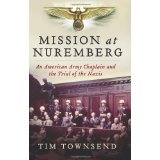 Christian ministers seek the lost, proclaim God’s gospel of faith and repentance to all who will listen, and refuse pastoral care to no one who seeks it. Their commitment leads them to minister in dark places of human depravity. The prison complex of the Palace of Justice in Nuremberg, Germany was such a place.
Christian ministers seek the lost, proclaim God’s gospel of faith and repentance to all who will listen, and refuse pastoral care to no one who seeks it. Their commitment leads them to minister in dark places of human depravity. The prison complex of the Palace of Justice in Nuremberg, Germany was such a place.
Housed there in 1945-46 were prominent architects of the Nazi war machine and its “Final Solution,” standing trial for crimes against peace and humanity. With them was Missouri Synod Lutheran pastor and United States Army Chaplain Henry Gerecke, who provided pastoral care to the Protestants among them.
At age 50 Gerecke joined the U.S. Army Chaplain Corps. His years of leadership at City Mission in St. Louis were distinguished by care for the poor, the sick, and the imprisoned. His earnest devotion to the evangelical gospel led to many conversions.
After joining the Chaplain Corps, he worked in hospitals in England prior to receiving orders to go to Nuremberg. Tim Townsend’s Mission at Nuremberg admirably tells the story of Gerecke’s fears of facing monstrously evil men. Caring for their souls and for their families required subordinating his own moral revulsion to the demands of gospel ministry. In the early morning hours of April 16, 1946, he walked to the gallows with those condemned to die. He never wavered in pleading with them to be right with God through faith in Jesus Christ. During his year of ministry, some were led to faith; others died stedfast in their unbelief.
Not surprisingly, his ministry was sharply criticized by those who believed the accused should face their fates bereft of the care and compassion they denied their victims.
Mission at Nuremberg also remembers the ministry of Roman Catholic priest Sixtus O’Connor, age 36, who cared for the Catholics on trial. In the preceding months, O’Connor performed his chaplain’s duties amidst the extreme conditions of combat and ghastly concentration camps, recently liberated by Allied forces. While serving at two camps (Mauthausen and Gusen), he filed this report:
“From 8 May until 31 May [1945] I conducted burial services for 1,834 inmates of Camp Mauthausen and for 1,0777 inmates of Camp Gusen. I also visited the hospitals of these two camps and administered the last rites of the Catholic Church to more than 2,000 patients. I found Catholic priests in both camps and secured Mass kits for them and with their help arranged for both daily and Sunday Mass in these Camps. My work still continues at both places.”
The author notes that O’Connor “made nearly forty trips to the camp cemeteries and buried about one hundred people with each service.” (208)
I recommend this book, but not without qualification. At several places the author strays from telling his story and launches into unhelpful forays on the veracity of biblical prophecy (106-7), theodicy (218-21), the documentary hypothesis (248-9), and the doctrine of salvation (286-7).
That said, this book provides much reflection for pastors who serve in communions like mine, committed to traditional pastoral care, and who confess that “as there is no sin so small, but it deserves damnation; so there is no sin so great, that it can bring damnation upon those who truly repent” (Westminster Confession of Faith, 15.4).
_____
Tim Townsend, Mission at Nuremberg: An American Army Chaplain and the Trial of the Nazis. New York: William Morrow, 2014.